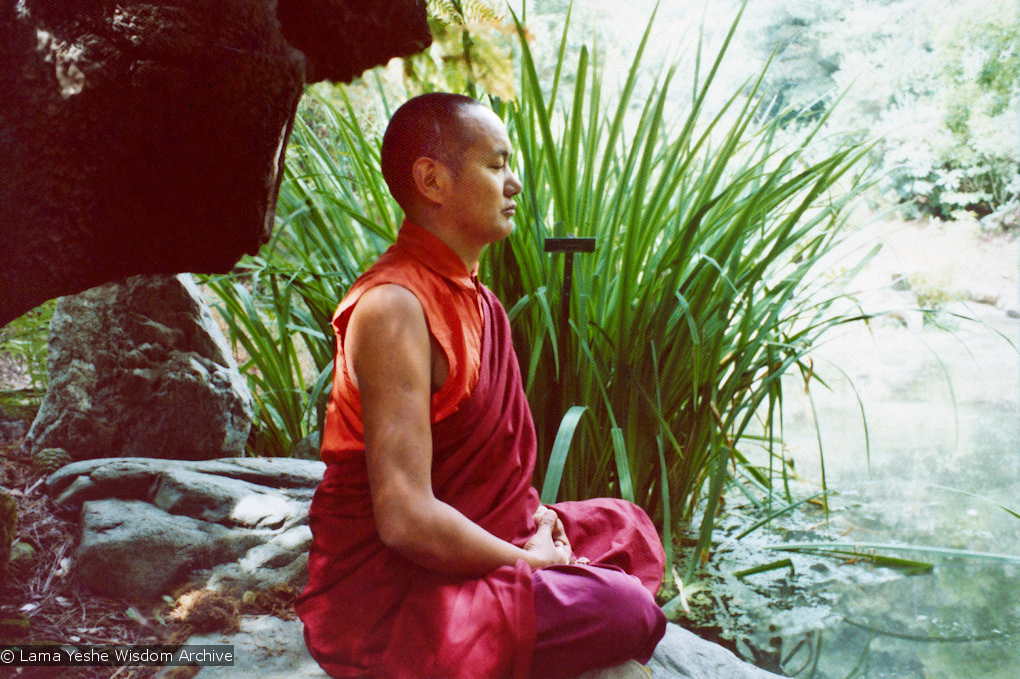In March 2014, I booked my ticket to Nepal.
For some reason, I felt a strong urge to visit Kopan Monastery in Kathmandu. There I attended daily dharma talks and spent a few days watching the students learning Buddhism courses. At that time I was leading a 9 to 5 office job, and I didn’t have the time to enroll in any of the full courses. However, I did promise myself that one day I would.
One year later, I quit my job and traveled to India. At the end of my trip, other travelers informed me about the Tushita Meditation Centre, where I could learn more about Buddhism. Without having any idea about the connection between Kopan Monastery and Tushita Meditation Centre, I booked my ticket this year back to India and registered for the Introduction to Buddhism course at Tushita.
On the way to India, at the airport, I came across an article by a monk named Lama Yeshe on elephant journal. He tackled the ego and the dangers of attachment. I was startled by his words. I didn’t know anything about him—whether he was alive or deceased, or whether he had published any books. Nevertheless, I remembered the name “Lama Yeshe” and I was keen on finding out more about him.
On day one of the Introduction to Buddhism course, they had us gather in the big gompa where the nun gave us guidelines for the 10 upcoming days. I took a seat right next to a wall, and they locked the room.
Before delving in the precepts we had to respect, the nun told us about the history of Tushita—as she did, I sat speechless, covered with goosebumps for the next hour.
It turned out that Tushita Meditation Centre was founded by Lama Yeshe in 1972, in response to the growing requests of Western students whom Lama Yeshe taught in Nepal, in Kopan Monastery, which he founded as well. And out of respect to his abiding presence in the center, they kept his room intact, locked, and built the gompa around it.
The wall I was leaning on was the wall of his room.
I was startled when I retraced how the events in my life led me to Kopan Monastery and Tushita, both of which were founded by him. The surprise of finding his article online and leaning on the wall of his room left me even more surprised.
After this beautiful incident, I ascertained that some teachings find their way to us. In 2014 and 2016, I suffered the consequences of attachment, but thanks to the teachings of Lama Yeshe I could let go of most of them, and here I am today.
Lama Yeshe passed away at the age of 59 in 1984; however, he is still known in Nepal and India for his wise teachings about the dangers of attachment.
While reading his words, I find myself pausing many times to ascertain just how right he is.
He basically explains that attachment is the biggest problem on earth, and once we learn how to let go if it, we will experience true abundance, freedom and joy.
Thanks to Lama Yeshe’s teachings, I have reflected on my own past and am now convinced that I am the cause of my misery, which is the result of my own attachments.
Below are 14 of his sayings that have personally helped me during the Introduction to Buddhism course:
“Your ego makes a wrong projection on an object and your attachment follows without hesitation and gets completely stuck on, or tied to that object. This splits and severely agitates your mind.”
“All worry and weeping, missing and memory, comes from the two mental departments of ego and attachment. Not understanding the impermanent nature of phenomena and expecting to live happily ever after, as ego and attachment wish, brings the reaction of misery.”
“Attachment has nothing to do with the material value of an object. It’s not like the more expensive something is the greater your attachment to it. It doesn’t depend on its outer valuation. Ego and attachment are what give things their value. It depends on the mind.”
“What you need to decide once and for all is: ‘I’m tired of being a servant to my ego.'”
“You don’t have to change anything external; the only change you need to make is within your mind. As soon as you change your projection, the outside world changes too.”
“It would be wonderful if you could recognize that you own attachment is the cause of every single problem that you experience. Problems with your husband, wife, children, society, authorities, everybody; having a bad reputation; your friends not liking you; people talking badly about you; hating your teacher. All this comes from your own attachment. You check up.”
“When you get hurt because somebody calls you greedy, you blame that person for how you feel. Actually, feeling hurt comes from your own attachment. Instead of of accepting their pointing out your selfish behavior, your attachment to always being right, to being perfect, causes you angrily to reject what they say.”
“The moment your ego says ‘I,’ you automatically identify yourself as totally separate from other atoms, other people. On the basis of this view of two different things—self and others—you automatically see ‘I’ as the most important one. Then, with attachment, your narrow mind chooses one particular atom as a source of sense of pleasure. That’s the way it all starts.”
“Things you see can have a strong effect on you. Therefore it’s very important that you remain aware of how the people and things around you affect your mind. Check up. Are they stimulating attachment or hatred? If you are psychologically alert you can easily tell, but usually you ignore your internal world.”
“If you conquer your worst enemy—the internal enemy of attachment—you will control all external energy, all other people, but if you try to exercise such control using just the power of your ego, it will be impossible. You think you can control others, but you can’t.”
“You must recognize that your real enemy, the thief who steals your happiness, is the inner thief, the one inside your mind—the one you have cherished since beginning-less time. Therefore, make the strong determination to throw him out and never let him back in.”
“When you choose to help others out of attachment it often results in their generating attachment to you. It’s as if you’d sent a thief to steal their peace of mind. This kind of thief is much worse than the kind who simply steals your furniture. Peace of mind is much harder to replace than a few chairs. You can’t buy peace of mind in a store no matter how rich you are. Therefore, check up whether your assistance really helps or not. Does it solve problems or create more? “
“As long as you direct your energy into the channel of peace and wisdom it will spontaneously flow that way. You don’t need to think too much. Just act in the right way and do your best to gain realizations; that’s enough.”
“We always evaluate actions by their appearance: ‘He did this; that’s bad. She did that; that’s good.’ We think that actions are fixed as good or bad. There’s no such thing as an action that’s always good or bad; actions can’t be categorized in that way. It all depends on the mind.”
~
Author: Elyane Youssef
Image: Lama Yeshe meditating in the botanical gardens, Berkeley, California, 1974. Photo donated by Judy Weitzner.
Editor: Emily Bartran








Read 0 comments and reply